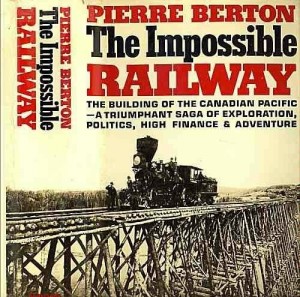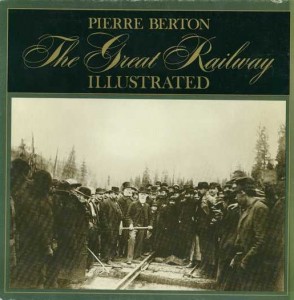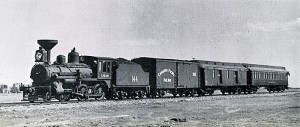Pierre Berton and the National Dream – Part 4 of 10
This is the fourth in a series of ten posts from an article prepared by Derek Boles, our TRHA historian on the occasion of the 35th Anniversary of the Groundbreaking TV “National Dream” Series – Russ Milland
The National Dream was published in 1970 and The Last Spike in 1971. Both were immediate runaway best sellers and the first Canadian books chosen as featured volumes for the U.S. Book-of-the-Month club. The Last Spike won the Governor General’s Literary Award for Nonfiction.
 The books were so popular that a combined and condensed edition was prepared in 1972 for the U.S. market titled “The Impossible Railway: the Building of the Canadian Pacific.” It was then and still is highly unusual for a book about Canadian history to be published separately in the United States.
The books were so popular that a combined and condensed edition was prepared in 1972 for the U.S. market titled “The Impossible Railway: the Building of the Canadian Pacific.” It was then and still is highly unusual for a book about Canadian history to be published separately in the United States.
Pictured at the left is the cover of the condensed U.S. Edition published in 1972.
.
.
 Given the tremendous success of the two books and the fact that neither of them included any photographs, an illustrated edition “The Great Railway – Illustrated” was also published by McClelland & Stewart in 1972, featuring hundreds of photographs, maps and engravings from the period.
Given the tremendous success of the two books and the fact that neither of them included any photographs, an illustrated edition “The Great Railway – Illustrated” was also published by McClelland & Stewart in 1972, featuring hundreds of photographs, maps and engravings from the period.
Pictured at the left is the cover of the illustrated edition also published in 1972.
.
.
The Canadian Broadcasting Corporation adapted the books into a television series in 1973. The script was written by award-winning author Timothy Findley and his partner William Whitehead. CPR Historian Omer Lavallee provided much of the reference material and photographs that were used by the CBC production designers to recreate the 1880s period.
The challenge was then to locate old railway equipment that could be used for filming the production. The CPR’s Dominion Atlantic subsidiary in Nova Scotia provided two open-platform boarding cars, which were former 100 series suburban coaches modified in CP’s Weston Shops in Winnipeg to create first class coach No. 141.  The railway also located and modified a wooden boxcar and then fabricated a truss-rodded flat car at Ogden Shops since no such car could be found anywhere on the system. An open-platform baggage car built for the Intercolonial Railway was provided by the Alberta Pioneer Railway Association since these types of cars had long disappeared from Canadian Pacific’s inventory, even in work train service.
The railway also located and modified a wooden boxcar and then fabricated a truss-rodded flat car at Ogden Shops since no such car could be found anywhere on the system. An open-platform baggage car built for the Intercolonial Railway was provided by the Alberta Pioneer Railway Association since these types of cars had long disappeared from Canadian Pacific’s inventory, even in work train service.
 The railway also located and modified a wooden boxcar and then fabricated a truss-rodded flat car at Ogden Shops since no such car could be found anywhere on the system. An open-platform baggage car built for the Intercolonial Railway was provided by the Alberta Pioneer Railway Association since these types of cars had long disappeared from Canadian Pacific’s inventory, even in work train service.
The railway also located and modified a wooden boxcar and then fabricated a truss-rodded flat car at Ogden Shops since no such car could be found anywhere on the system. An open-platform baggage car built for the Intercolonial Railway was provided by the Alberta Pioneer Railway Association since these types of cars had long disappeared from Canadian Pacific’s inventory, even in work train service.
Pictured above is the 1880s-era CPR passenger train assembled from all over Canada for the filming of the TV series. Click on the picture for a closer look!
By Derek Boles, TRHA Historian
Click here to read Part 5.
Click here to return to Part 3.
http://www.trha.ca

